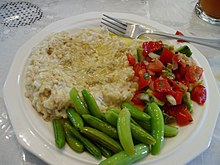Cookbook:Cuisine of Armenia
Cookbook | Ingredients | Cuisines


Armenian cuisine is the cuisine of Armenia or of the Armenians in the Armenian Diaspora. Given the geography and history of Armenia, Armenian cuisine is a representative of the cuisine of the Mediterranean and the Caucasus, with strong influences from Eastern Europe, the Middle East, and, to a lesser extent, from the Balkans. It is also to note that Armenians themselves have greatly influenced the culinary traditions of nearby countries or cities, such as Aleppo.[1] The preparation of a large number of meat, fish and vegetable dishes in the Armenian kitchen requires stuffing, frothing and pureeing.[2]
Meals
[edit | edit source]Appetizers
[edit | edit source]
- Boeregs -- savory pies made with phyllo pastry and stuffed with cheese
- Hummus -- smooth chickpea paste
- Narsharab
- Sarma -- cabbage leaf roll filled with meat, rice and onions
- Telov panir -- string cheese
Barbecue
[edit | edit source]
Barbecue is very popular in Armenia, and makes the primary offer of main courses in most restaurants. It is often eaten as fast food.
- Khorovats -- kebab: grilled meat (beef, lamb, chicken, fish)
- Gharsi Khorovats
Soups
[edit | edit source]
- Brindzapour
- Chkhrtma
- Chorba
- Dzavarapour
- Flol
- Harissa -- porridge with chicken
- Katnapour

- Khash -- boiled cow's feet (considered a delicacy)
- Katnov
- Kololik
- Mantapour
- Matsnaprtosh
- Poutouk
- Sarnapour
- Sounkapour
- Spas
- Tarkhana -- flour and yogurt soup
- Vospnapour
Seafood
[edit | edit source]- Crawfish Served with beer.
- Ishkhan -- Sevan trout
- Karmrakhayt
- Kogak
- Sig -- Cisco fish
Main course
[edit | edit source]- Adjapsandal
- Fasulya -- a stew made with green beans, lamb and tomato broth or other ingredients
- Ghapama -- pumpkin stew
- Karmir plav -- red rice with beef especially common among Persian-Armenians
- Ktchoutch
- Koufte -- fried or boiled dumplings consisting of spiced ground beef (sometimes with pine nuts) surrounded with a thin shell of bulgur and meat

- Lahmajoun -- soft flatbread topped with mince meat(usually beef, sometimes lamb), tomatoes and onions.
- Moussaka -- baked dish consisting of spiced lamb and aubergine
- Mujaddara -- cooked lentils and rice
- Parinje plav or hajare plav -- a grain pilaf common among Persian-Armenians
- Plav -- fried rice
- Tjvjik -- fried liver and kidney with onions
- Tolma -- spiced rice and meat wrapped in vine leaves or stuffed in squash or peppers.
- Sarma -- cabbage leaf roll filled with meat, rice and onions
Meat products
[edit | edit source]- Bastourma -- highly seasoned, air-dried cured beef
- Soujoukh -- dry, spicy beef sausage
- Yershig -- smaller, spiced pork sausage

Dairy products
[edit | edit source]- Labneh -- Dense yogurt made from sheep, cow, or goat milk. Often served with olive oil and spices.
- Matsoun -- yogurt
- Ttvaser
Bread
[edit | edit source]
- Choreg -- a sweet breakfast bread, often rolled into a thin layer, rolled up and eaten by unpeeling the layers
- Lahmajoun -- soft flatbread topped with mincemeat
- Lavash -- soft, thin flatbread
- Matnakash -- soft and puffy bread
- Zaatar (with thyme)
- Zhengyalov hats -- bread stuffed with herbs, a speciality of Artsakh (Nagorno-Karabakh) cuisine
Salads
[edit | edit source]Sweets
[edit | edit source]
- Alani
- Pakhlava -- sweet phyllo pastry filled with pistachio paste and covered in honey
- Burek -- savory phyllo pastry filled with meat, cheese or vegetables
- Gata -- sweet bread
- Ghataif -- phyllo pastry
- Halva -- ground and compacted sesame sweetened with honey
- Kozinakh
- Nazuk
- Noush
- Perok
- Ponchik
Ritual
[edit | edit source]- Aghablit -- salty bread taken the night of Surb Sargis Day (Feb. 14th) by youngsters, which can then cause them to see who their future partner will be, by offering them water in their dream
- Nshkhar -- bread given to churchgoers after the Holy Badarak (Holy Mass)
- Matagh -- sacrificial meat
- Paska -- cylindrical pastry made on Easter, usually decorated by colored eggs around it and a cross on top
- Pokhindz -- enjoyed on Trndez
Drinks
[edit | edit source]
Non-alcoholic
[edit | edit source]- Armenian Coffee -- strong black coffee, finely ground, sometimes sweet
- Jermuk -- mineral water
- Kefir -- fermented milk drink
- Kvas -- sweet, fermented bread drink
- Tan (carbonated)
- Hayq
- Gazoz
Alcoholic
[edit | edit source]References
[edit | edit source]- The Cuisine of Armenia by Sonia Uvezian, Dikran Palulian (Illustrator)
- ↑ [ My kind of town: Aleppo http://www.telegraph.co.uk/travel/main.jhtml?xml=/travel/2007/05/20/etmyaleppo120.xml]
- ↑ Pokhlebkin, V. V. Russian Delight: A Cookbook of the Soviet People. London: Pan Books, 1978
